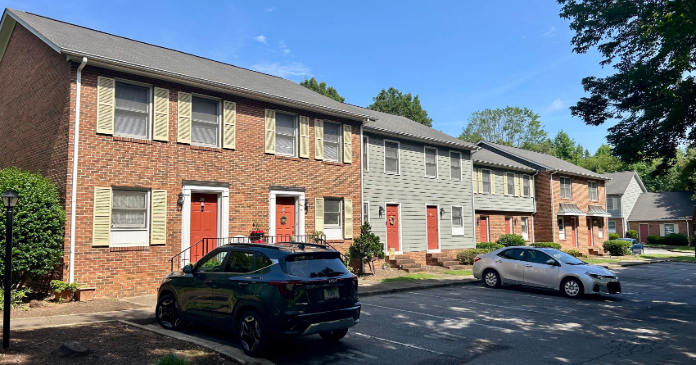Restricting the price of housing kills incentives to supply places to live.
Rent control is having something of a moment: In Los Angeles, tenants are invoking a law that imposes limits on apartments built on sites where rent-controlled units previously stood. A new rent control ordinance went into effect in April in the Bay Area city of Concord, California. Phillipsburg, New Jersey, is considering similar restrictions. And, importantly, the Biden administration recently moved to cap rent hikes in some federally subsidized housing across the entire country.
But reviving bad policy doesn’t make it less dumb than it was in past incarnations.
Affordable housing comes at high price
“The Biden administration moved in March to limit how much rent can rise in certain affordable housing units across the country,” CNBC’s Annie Nova noted April 3. “The cap applies to units that receive funding from the Low-Income Housing Tax Credit, the nation’s largest federal affordable housing program, according to experts.
The National Low-Income Housing Coalition estimates that around 2.6 million rental homes across the U.S. have current LIHTC rent and income restrictions.”
Tenant advocates applauded the move, but it drew criticism, too.
“While well-intentioned, rent control fails to achieve its primary goal of improving housing affordability for the poor and disadvantaged,” economists Jeffrey Miron and Pedro Aldighieri responded in a piece published by the Cato Institute. “In fact, it often generates unintended consequences that exacerbate the very problems it seeks to solve.”
They point out that restricting the price of housing discourages owners from maintaining and improving their property. It can also make it attractive for landlords to pull apartments from the rental market and sell them as owner-occupied dwellings. Those enjoying deals on housing costs might also find themselves in the equivalent of golden handcuffs.
“Tenants in rent-controlled units become less mobile to avoid losing access to below-market rents,” add Miron and Aldighieri.
The authors point to studies finding that rent control has reduced the supply of rental housing in communities as far apart as Cambridge, Massachusetts, and San Francisco.
In fact, the use of the City by the Bay to illustrate the failures of rent control has a long history. It was the example offered by Milton Friedman and George Stigler in “Roofs or Ceilings?,” a 1946 essay on rent restrictions published by the Foundation for Economic Education and recently resurfaced on X by the author Amity Shlaes.
A tale of two housing crunches
Discussing the effects of the infamous April 18, 1906 earthquake, Friedman and Stigler pointed out that “a city of about 400,000 people lost more than half its housing facilities in three days.” In the weeks that followed, people left the city, temporary shelters went up, and construction crews swiftly got to work.
“When one turns to the San Francisco Chronicle of May 24, 1906—the first available issue after the earthquake—there is not a single mention of a housing shortage!” they write. “The classified advertisements listed 64 offers (some for more than one dwelling) of flats and houses for rent, and 19 houses for sale, against 5 advertisements of flats or houses wanted. Then and thereafter a considerable number of all types of accommodation except hotel rooms were offered for rent.”
Friedman and Stigler contrasted this to the post-war situation in 1946, when “the city was being asked to shelter 10 percent more people in each dwelling unit than before the war”—a less acute situation than the one faced in 1906. But the result in 1946 was very different from that faced 40 years earlier.
“During the first five days of the year in 1946 there were altogether only 4 advertisements offering houses or apartments for rent, as compared with 64 in one day in May 1906.”
That’s because, faced with a sudden mismatch between supply and demand, people decades apart chose very different ways of “rationing” housing stock.
“In 1906, the rationing was done by higher rents,” wrote Friedman and Stigler. “In 1946 the use of higher rents to ration housing has been made illegal by the imposition of rent ceilings, and the rationing is by chance and favoritism.” Higher rents in 1906 spurred people to build quickly and to efficiently use available space. Restricted prices in 1946 offered no such incentives, so housing remained hard to find.
That would have been a hard-learned lesson—had it been learned at all. But it wasn’t.
Lessons unlearned
Decades later, the 2019 study cited in May by Miron and Aldighieri looked at a 1994 law change in San Francisco that suddenly extended rent control to housing constructed before 1980. Sure enough, tenants benefiting from controlled rents became less likely to move, while landlords subject to restrictions converted their properties to condos and co-ops or redeveloped them to escape regulation.
Rent controls “reduced the supply of available rental housing by 15 percent,” the study concluded. “This reduction in rental supply likely increased rents in the long run.” Contrary to housing activists’ intentions, “the conversion of existing rental properties to higher-end, owner-occupied condominium housing ultimately led to a housing stock increasingly directed toward higher income individuals.”
So much for the magical benefits to the poor of price controls on housing. But, despite bitter experience of the ill-effects of rent controls, restricting the price that landlords can charge tenants for use of their property remains popular. Whether it’s the Biden administration or local politicians in California, New Jersey, and elsewhere, a policy that pretends to make homes affordable is a very visible way of demonstrating concern for low-income families—even if it’s completely counterproductive.
By contrast, the productive approach—getting out of the way—isn’t so headline-ready.
“The most sustainable and effective way to promote affordable rents is to enable new construction by deregulating zoning, land use, and building requirements,” write Miron and Aldighieri. “Such policies make development cheaper and supply more responsive to prices, keeping rents in check.”
Unfortunately, leaving the market free to match supply and demand for housing—or anything else—may meet human needs, but it doesn’t make for feel-good press releases. So, government officials continue to offer rent control as a solution to housing woes. And economists have endless opportunities to explore why restricting prices still fails to make housing affordable.
Author J.D. Tuccille writes The Rattler, a weekly newsletter












